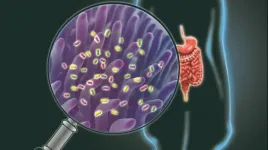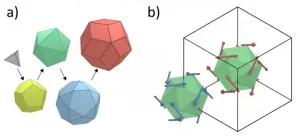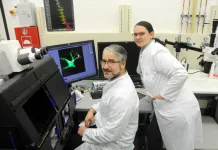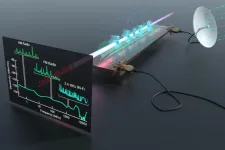Probiotics or prebiotics? Exploring the complex world of 'gut' health
University of Missouri researchers develop a noninvasive way for identifying the major functions of the gastrointestinal tract.
2021-02-04
(Press-News.org) A healthy person has a general balance of good and bad bacteria. But that balance is thrown off when someone gets sick. So, to help boost their levels of good bacteria, many people take probiotic supplements -- live bacteria inside of a pill. Various commercial probiotic supplements are available for consumer purchase, and while health experts generally agree about their overall safety, controversy surrounds their efficacy.
Inside the human body lives a large microscopic community called the microbiome, where trillions of bacteria engage in a constant "tug of war" to maintain optimal levels of good and bad bacteria. Most of this struggle takes place within the body's gastrointestinal tract, as bacteria help with digesting food and support the immune system. Although health experts believe good "gut" health is key to a person's health and well-being, scientists are still developing a detailed picture of what goes on inside a person's gastrointestinal tract.
"Until now, we have not had any ways to noninvasively monitor activity in the intact gastrointestinal tract, given the unique chemical environment, variable distribution and highly dynamic nature of the gut microbiota," said Elena Goun, an associate professor in the Department of Chemistry at the University of Missouri.
In a new study published in Science Advances, Goun and an international team of scientists have developed a noninvasive diagnostic imaging tool to measure the levels of a naturally occurring enzyme -- bile salt hydrolase -- inside the body's entire gastrointestinal tract. Goun said their tool accomplishes three major functions:
Predicts the clinical status of inflammatory bowel disease, such as Crohn's disease and ulcerative colitis.
Determines the efficacy of many commercially available probiotic supplements by testing for the level of bile salt hydrolase, which is responsible for all of the major health-promoting functions of probiotics.
Evaluates whether certain types of prebiotics -- dietary fibers known to support digestive health -- can increase bile salt hydrolase levels in a similar way that probiotic supplements do.
Goun, who specializes in the development of biomedical imaging tools to advance the knowledge and understanding of various processes underlying human diseases, believes their findings are exciting, especially with the discovery related to prebiotics, which can be naturally found in foods such as whole grains, nuts and seeds, and fruits and vegetables.
"Prebiotics are often used in combination with probiotics to enhance their functions in the body," Goun said. "We show for the first time that certain types of prebiotics alone are capable of increasing bile salt-hydrolase activity of the gut microbiota, which among other health benefits has been shown to decrease inflammation, reduce blood cholesterol levels, and protect against colon cancer and urinary tract infections. In my opinion, this discovery is huge because the production and storage of prebiotics is less expensive than with probiotics."
Previous reports have noted high bile salt-hydrolase activity of the gastrointestinal tract is reflective of better digestive health and a lack of inflammation in the body. Goun said their noninvasive method uses bioluminescence -- a chemical reaction that produces light inside a living organism -- to measure the level of bile salt-hydrolase activity throughout the entire gastrointestinal tract.
"Our imaging tool is a bioluminescent probe in the form of a capsule," Goun said. "When someone swallows it, it's exposed to the intact gut microbiota while traveling throughout the harsh environment of a person's entire gastrointestinal tract. After it passes out of the body, we can analyze a person's stool sample. We can take the results from that analysis and correlate it with the amount of bile salt-hydrolase activity within the human gastrointestinal tract."
Goun believes this research could lead to better precision medicine treatments by providing a way for scientists to better understand how a person's individual gut health is connected to various human pathologies, or the origin and nature of human diseases.
"This is the first example of the use of bioluminescent imaging probes in humans," Goun said. "The gut microbiome plays a huge role in various health issues such as cancer, diabetes, obesity, Parkinson's disease, depression and autism, and now, this new tool will help us better understand the relationship between the gut function and these diseases. In addition, it will allow us to develop more effective probiotics and prebiotics to improve gut health."
INFORMATION:
Highlighting the promise of personalized health care and the impact of large-scale interdisciplinary collaboration, the University of Missouri System's NextGen Precision Health initiative is bringing together innovators from across the system's four research universities in pursuit of life-changing precision health advancements. It's a collaborative effort to leverage the strengths of Mizzou and entire UM System toward a better future for Missouri's health. An important part of the initiative is the construction of the new NextGen Precision Health building, which will expand collaboration between researchers, clinicians and industry leaders in a state-of-the-art research facility.
"Noninvasive imaging and quantification of bile salt hydrolase activity: from bacteria to humans," was published in Science Advances. This was a highly collaborative work, including institutions such as the Swiss Federal Institute of Technology in Lausanne, Switzerland; Nestlé Institute of Health Sciences in Lausanne, Switzerland; University of North Carolina at Chapel Hill; and Nationwide Children's Hospital in Columbus, Ohio.
[Attachments] See images for this press release:

ELSE PRESS RELEASES FROM THIS DATE:
2021-02-04
New research carried out by City data scientist, Dr Andrea Baronchelli, and colleagues, into the dark web marketplace (DWM) trade in products related to COVID-19, has revealed the need for the continuous monitoring of dark web marketplaces (DWMs), especially in light of the current shortage and availability of coronavirus vaccines.
In their paper, Dark Web Marketplaces and COVID-19: before the vaccine published in the EPJ Data Science journal, Dr Baronchelli and his colleagues analysed 851,199 listings extracted from 30 DWMs between January 1, 2020 and November 16, 2020 before the advent of the availability of the coronavirus vaccine.
They identify 788 listings directly related to COVID-19 products and monitor the temporal evolution of product categories including Personal Protective ...
2021-02-04
Researchers from the University of Missouri School of Medicine have discovered that children who receive a seasonal flu shot are less likely to suffer symptoms from a COVID-19 infection. The finding comes from a review of more than 900 children diagnosed with COVID-19 in 2020.
"It is known that the growth of one virus can be inhibited by a previous viral infection," said Anjali Patwardhan, MD, professor of pediatric rheumatology and child health. "This phenomenon is called virus interference, and it can occur even when the first virus invader is an inactivated virus, such as the case with the flu vaccine."
Patwardhan reviewed records from 905 pediatric patients diagnosed with COVID-19 between February and August 2020 to determine each patient's influenza vaccination history. ...
2021-02-04
Cardiac patients who also have diabetes will be able to do their rehabilitation exercises more safely, thanks to the world's first guidance on the subject, which has been published by international experts including a Swansea University academic.
The guidance will be a crucial resource for healthcare professionals, so they can help the growing number of cardiac rehabilitation patients who also have diabetes.
The guidance, approved by international diabetes organisations, was drawn up by a team including Dr. Richard Bracken of the School of ...
2021-02-04
Scientists at Bielefeld University's Faculty of Physics have succeeded for the first time in imaging the SARS-CoV-2 coronavirus with a helium ion microscope. In contrast to the more conventional electron microscopy, the samples do not need a thin metal coating in helium ion microscopy. This allows interactions between the coronaviruses and their host cell to be observed particularly clearly. The scientists have published their findings, obtained in collaboration with researchers from Bielefeld University's Medical School OWL and Justus Liebig University Giessen, in the Beilstein Journal of Nanotechnology.
'The study shows that the helium ion microscope is suitable for imaging coronaviruses - so precisely that the interaction between virus ...
2021-02-04
People undergoing long-term dialysis are almost 4 times more likely to die from COVID-19 and should be prioritized for vaccination, found a new Ontario study published in CMAJ (Canadian Medical Association Journal).
"As the COVID-19 pandemic proceeds, focused efforts should be made to protect this population from infection including prioritizing patients on long-term dialysis and the staff treating them for SARS-CoV-2 vaccination," writes Dr. Peter Blake, provincial director, Ontario Renal Network, Ontario Health, and professor, Schulich School of Medicine and Dentistry, Western University, ...
2021-02-04
It is necessary to develop additional COVID-19 vaccines, as different vaccine approaches have their advantages and disadvantages and may work synergistically. Researchers at Karolinska Institutet in Sweden now report that they have developed a prototype vaccine against SARS-CoV-2 using a DNA vaccine platform that is inexpensive, stable, easy to produce, and shows a good safety profile. A study published in Scientific Reports shows that the vaccine induces potent immune responses in mice.
The vaccine, called DREP-S, is administered as DNA and is based on a DNA-launched self-amplifying RNA (DREP) platform developed at Karolinska ...
2021-02-04
Between chemistry classes, gemstones, and electronics, the idea of crystals, substances with an ordered and periodic arrangement of atoms is quite common. But about 40 years ago, a strange particle was discovered by scientists that hasn't become commonplace in our world yet: quasicrystals. These are structures with curious atomic arrangements, which, while superficially similar to crystals, lack periodicity despite being ordered. Because of their structures, quasicrystals exhibit symmetries forbidden to crystals and are endowed with interesting properties that crystals cannot show, ...
2021-02-04
The unmet HIV prevention and treatment needs of female sex workers and especially their male clients could contribute substantially to ongoing HIV transmission in South Africa, according to a new study led by researchers at the University of Bristol, UK.
The researchers used mathematical modelling to look at the contribution of commercial sex, sex between men, and other heterosexual partnerships to HIV transmission in South Africa.
They found that, over a ten-year period (2010-19), sex between female sex workers and their paying clients contributed 6.9 per cent of new HIV infections, while ...
2021-02-04
In order to fight pathogens, mast cells regulate inflammatory reactions of the immune system. Both mast cells and neutrophils are white blood cells and are critical for the body's immune defense. A team of scientists around the immunologist Prof. Dr. Anne Dudeck and the bioengineer Jan Dudeck has discovered a crucial aspect of the communication between mast cells and neutrophils. These new findings may allow for developing innovative, targeted therapeutic strategies to dampen allergic responses and inflammatory reactions. The results have been published ...
2021-02-04
ADELPHI, Md. -- A new quantum sensor can analyze the full spectrum of radio frequency and real-world signals, unleashing new potentials for soldier communications, spectrum awareness and electronic warfare.
Army researchers built the quantum sensor, which can sample the radio-frequency spectrum--from zero frequency up to 20 GHz--and detect AM and FM radio, Bluetooth, Wi-Fi and other communication signals.
The Rydberg sensor uses laser beams to create highly-excited Rydberg atoms directly above a microwave circuit, to boost and hone in on the portion of the spectrum being measured. The Rydberg atoms are sensitive to the circuit's voltage, enabling the device to be used as a sensitive probe for the wide range of signals in the RF spectrum.
"All ...
LAST 30 PRESS RELEASES:
[Press-News.org] Probiotics or prebiotics? Exploring the complex world of 'gut' health
University of Missouri researchers develop a noninvasive way for identifying the major functions of the gastrointestinal tract.






